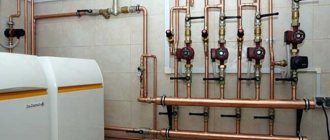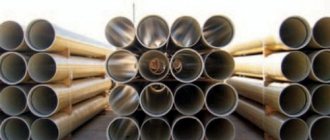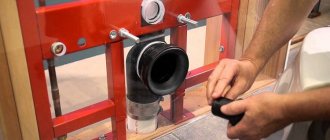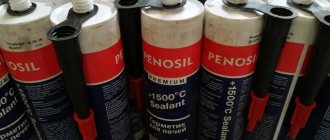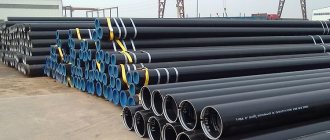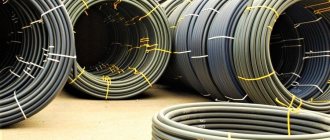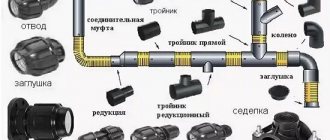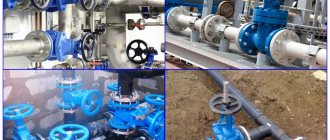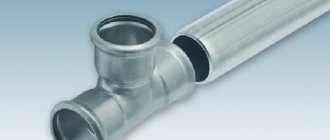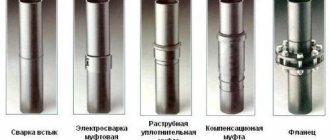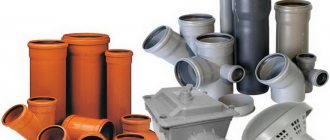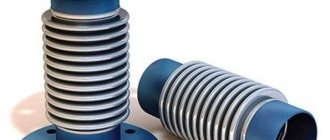A pipeline is a structure made of pipes, which includes:
- Pipes;
- Various types of parts required to assemble the pipeline into a single whole;
- Pipeline fittings – control and shut-off valves, faucets, taps, gate valves, etc.;
- and so on.;
pipelines are designed for - moving gaseous, bulk and liquid substances through them.
Depending on the type of medium moving through the pipeline, its name is determined: steam pipeline, oil pipeline, water supply system, gasoline pipeline, gas pipeline, milk pipeline, etc.
All GOSTs mentioned in the text at the time of writing (01/24/2018) are valid.
Conventionally, pipelines are classified according to the block diagram below:
(block diagram)
Process pipelines
Industrial process pipelines include pipelines located on the territory of an industrial facility, as well as those on the balance sheet of an institution that are intended for pumping water, steam, various raw materials, chemical reagents, fuel, semi-finished products, production waste and other materials (a similar definition can be found in GOST 32569 -2013).
Technological pipelines are necessary for conducting technological processes and operating various technological equipment.
Pipelines are also classified depending on their location: inter-shop, intra-shop, piping - necessary for the operation of a separate unit (compressor, pump, tank piping, etc.)
Pipelines for heating buildings, storm sewerage, drinking water and various plumbing purposes do not belong to process pipelines.
Classification according to the danger of the transported environment
Depending on the classification of the transported substance, process pipelines are grouped into three main groups (A, B, C) and five categories (I, II, III, IV, V). Table 1, according to GOST 32569-2013.
Groups and subgroups divide substances according to fire hazard, explosion hazard and harmfulness to the human body and the environment.
Categories divide substances according to parameters such as temperature and pressure.
- The group is determined based on the hazard class of harmful substances according to GOST 12.1.005-88 and GOST 12.1.007-76 when determining the degree of fire and explosion hazard, one should be guided by GOST 12.1.044-89 (ISO 4589-84).
- The category is selected based on the parameters of the transported medium (pressure and temperature).
An example of a pipeline designation: “Pipeline IV group B (c)” means that the pipeline transports a substance of group “B”, subgroup “c” and the parameters of category IV.
Industrial hot water and steam pipelines
This type of pipeline refers to energy pipelines, designed to move hot water, saturated steam and superheated steam.
This type of industrial pipelines includes pipes with working environment parameters at temperatures above 115°C and excess pressures (working) of more than 0.7 kgf/cm2 (0.07 MPa).
According to the rules (NP-045-03), steam and hot water pipelines, depending on operating temperature and pressure, are divided into categories and groups, which are shown in Table 2.
Results
- Pipeline fittings are parts for connecting pipes into one system.
- The elements are designed for highway turns, branches, and intersections.
Using shaped pipes, pipes made of different materials are connected. (An additional polypropylene outlet is cut into the cast iron main)- Fittings are available for different connection methods. Installation with or without additional special equipment.
- Materials of manufacture: polypropylene, polyethylene, plastic, metal, cast iron, brass.
- Installation can be detachable or monolithic (one-piece)
- The diameter of the fitting is selected according to the diameter of the pipeline.
- The installation method depends on the purpose of the pipeline.
- Large diameter fittings are used in industry (oil pipeline, gas pipeline)
- Elements are manufactured according to GOST
Water pipelines
This type of pipeline is necessary to provide water to industrial facilities and the population; depending on the purpose, water pipelines are divided into different classes:
- Production;
- Fire protection;
- Household drinking water;
- Irrigation;
For different types of water supply systems, it is necessary to apply their own rules and regulations.
Water supply networks are also classified depending on the connection diagram:
- Zone water supply networks - more than one water supply network at one facility (for example, a building), separated or connected to each other.
- Dead-end water pipelines are used at facilities where interruptions in the water supply are allowed (in the event of a water supply failure), such facilities may include industrial buildings, administrative and residential buildings.
- Ring - this class of water supply networks is used for uninterrupted supply of water to consumers, as a rule, these are multi-storey buildings and fire-fighting water supply systems. This type of pipeline has more than one input into the building, which allows you to switch to another in the event of a supply interruption through one input.
- Combined water supply network - combines dead-end main and ring lines, used for large buildings with high water consumption.
Main water supply
A class of pipelines designed to provide water supply over long distances. Water supply networks from water intake points to the consumer (industrial facilities and public utilities).
Cast iron pipes
Cast iron pipelines are resistant to corrosion, however, they are not as durable as steel ones. Among other disadvantages, they are heavy and require reliable fastenings for their installation.
Plumbing structures, as well as heating and sewer lines are assembled from cast iron parts. Today, there are three types of cast iron pipes, differing from each other in terms of strength:
- black cast iron;
- gray cast iron (more durable);
- products made of high-strength nodular cast iron (ductile iron).
Parts cast from gray cast iron have good strength and have rough walls. Ductile iron pipes are highly durable and can withstand heavy loads in the soil or under the road surface. The diameter of cast iron products varies from 50 to 1000 mm. The service life of such pipes is 20–50 years.
There are the following types of cast iron pipes according to the connection method:
- bell-shaped;
- products joined using caulking.
Cast iron pipes are strong, but fragile, so they require caution when working with them
Sometimes, to improve anti-corrosion characteristics, cast iron pipelines are coated with a protective coating of varnish or bitumen.
Oil pipelines
Types of pipelines intended for transporting petroleum products and oil itself.
Depending on the substance being transported, pipelines are divided into different classes and get their name depending on the petroleum product being transported:
- Fuel oil;
- Kerosenov;
- Gasoline;
- And so on.;
The oil pipeline that provides transportation between various units and oil wells is called “Field Pipeline”.
Main oil pipeline
Type of oil pipelines used to transport oil and petroleum products over long distances.
Pipelines of this type are classified depending on the nominal diameter (DN) of the pipelines:
I - from DN1000 to DN1200.; II - the same, over DN500 to DN1000.; III - the same, over DN300 to DN500.; IV - DN300 or less;
The main oil pipeline should be assigned a category according to Table 3 (SNiP 2.05.06-85):
Scope of application of fittings
Shaped parts are used in the following cases:
- if you need to connect steel pipes with a diameter of 260 mm with an ethinol coating that has anti-corrosion properties;
- if it is necessary to join thin-walled steel pipes with a spiral-type seam with a diameter of 260 mm and a zinc double-sided coating;
- if you need to connect steel pipes whose wall thickness ranges from 160 to 1250 mm;
- if it is necessary to join electric-welded steel pipes D 160-430 mm;
- if you need to connect thin-walled steel pipes with varnish ethinol coating. The diameter of the pipes ranges from 220 to 450 mm;
- if it is necessary to connect asbestos-cement pipes D 140-550 mm;
- if you need to combine polyethylene pieces D150-350 mm;
- if you need to join cast iron sections D 140-450 mm.
Steel flanged fittings on the pipeline in the form of: couplings, tees and 45º elbows after the wedge valve
In general, the use of shaped elements is necessary, if necessary, to give the pipeline a new direction, to change the diameter of the pipeline, when adding new branches to the water supply system, to make the system tight, to change the angle of inclination of the liquid flow, and also for greater ease of operation of the water supply system.
Materials for the manufacture of shaped parts
Various materials are used to produce shaped parts. The variety of compositions is determined by the variety of water supply systems. The following shaped products are considered the most popular:
- steel parts;
- galvanized;
- plastic parts;
- polymer.
Gas pipelines
Classification of pipelines providing transportation and distribution of gas from gas fields (or plants) to consumers.
Gas pipelines are divided into categories depending on pressure; the categories of gas pipelines are shown in Table 4:
The pressure of internal gas pipelines and installations using gas must correspond to the parameters specified in the documentation for specific equipment, but should not exceed the values specified in Table 5 (SNiP 42-01-2002 Gas distribution systems.)
Main gas pipelines
A class of gas pipelines designed to transport gas from factories or gas fields to gas distribution stations (GDS). Then (after the gas distribution system) the gas enters the gas supply network (industrial facilities, cities, towns, etc.).
Depending on the pressure in the gas pipeline, pipelines are grouped into classes (SNiP 2.05.06-85):
I - over 25 to 100 kgf/cm inclusive. II - over 12 to 25 kgf/cm inclusive.
Types of shaped elements
There is a long list of shaped products that are used in different sections of pipelines to solve various problems. Among them:
- couplings - used for joining sections on straight sections of pipelines;
- bends – make it possible to effectively change the position of pipes;
- angles - give the system the desired tilt to set the fluid flow to the optimal degree;
- knees - make it possible to bypass problem areas of the system, as well as rotate it in the desired direction;
- tees - used to branch pipelines, for example, to connect to the main line;
- crosses - allow branching in opposite directions;
- collectors - in addition to leveling the pipeline environment, they are involved in mixing liquids that enter them from different pipes;
- transitions – used for a hermetically sealed transition between sections of different diameters;
- bottom - used to provide unobstructed access to the system for quick cleaning; performs the function of a kind of pallet;
- plugs - with their help you can temporarily seal one of the pipeline branches;
- flanges - allow you to make a hermetically sealed connection of pipes; connected to the main line using bolts;
Flange shaped elements in the form of: tee, bend, transition and cross
- cap – the second name of the product – cork; it allows you to seal the end of the pipe;
- fitting – is a threaded bushing;
- nipple - a coupling that is mounted inside the pipe using a threaded connection;
- valves - capable of completely or partially blocking pipelines;
- valves – suitable for installation of internal water supply systems; equipped with a through hole, which is closed using a spool valve;
- check valves - used to prevent the reverse outflow of liquid.
Fittings for polyethylene pipes
There are three types of polyethylene connecting products:
Castings are used in places where it is necessary to rotate pipes or change their diameter. They are manufactured under pressure from polyethylene with the following characteristics: MRS 1.0 MPa and MRS 1.25 MPa (PE 100).
Welded parts are produced by butt welding. The tightness and strength of the connection can be achieved thanks to high-quality factory equipment. Such parts are used in the same cases as cast parts of pipelines.
Flange parts are produced by welding ready-made connecting products (cast and segmented). They are used for the purpose of joining assemblies of polyethylene pipes with cast iron fittings.
Plastic bushing with flange for transition from plastic pipe to metal
Polyethylene shaped products can be connected to each other in the following ways:
- By welding, heating the ends of the parts.
- By electro-fusion welding using fittings.
- By flange joining.
The main requirement for a welded joint is the same thickness of the walls of the product.
Shaped cast iron parts
Cast iron parts for connecting pipes in a water supply system are manufactured in accordance with GOST 5525-50 (for water supply systems) and GOST 6942-54 (for sewerage systems).
Among the main advantages of cast iron parts:
- long service life up to 100 years;
- elasticity of connections;
- tensile strength;
- resistance to deformation;
- sound insulation;
- resistance to high temperatures.
Due to their anti-corrosion properties, cast iron parts can be used to connect:
- PVC products with sockets;
- asbestos pipes;
- polyethylene highways;
- cast iron systems.
Various methods are used to connect parts. For example, parts with smooth ends are joined by welding. Thin-walled pipes are connected using couplings. Sockets and bushings are also effective for joining thin-walled sections. Flanges are used for joining cast iron to polyethylene.
Methods for connecting fittings
Shaped products are joined together in several ways.
Their choice depends on the type of pipeline material. In general, they can be classified into two groups:
- detachable method;
- one-piece method.
The first method allows you to easily disassemble the pipeline if necessary, without harming the integrity of the entire system.
Removed flanged section of pipeline
The second method involves installing the elements “tightly”. Such a system can only be corrected by cutting out the broken part. However, such a connection cannot be avoided.
It is effective in places where the pipe is protected by a wall or “warm floor”.
There are the following methods of connecting system elements:
- threaded;
- fitting with soldering;
- pressing method;
- electric welded;
- thermowelded;
- push fitting, etc.
The fittings are installed simultaneously with the installation of the pipeline system. Their size must strictly correspond to the outer diameter of the segment from its smooth end and the inner diameter of the socket.
When installing the pipeline, you should use rubber O-rings, which are used to connect the joints between the sections.
Technology for connecting plastic shaped elements by soldering (video)
Sewage pipelines
Sewage pipelines are used for the removal and discharge of wastewater outside industrial facilities and populated areas.
In pressure sewer pipelines, the medium moves under excess pressure, in non-pressure pipelines - by gravity.
Sewage systems according to SNiP 2.04.01-85 are classified:
- Household - used to move wastewater from sanitary installations (toilets, bathtubs, washbasins, swimming pools, etc.);
- Industrial - used for the disposal of various types of industrial wastewater;
- Combined - used to move domestic and industrial wastewater “together”. If possible and permitted, their joint transportation and subsequent cleaning;
- Internal drains - used to remove rain and melt water from the roof of a building.
Design options for fittings
The methods of connecting modern pipeline systems are varied. According to the principle of their installation, the following can be distinguished:
- Threaded, they are mainly made from brass, steel, bronze, plastic and other lesser known materials. For a reliable, strong connection, different sealing materials are used, this can be hemp winding with red lead putty, flax, Teflon thread, paste, etc.;
- Compression (collet, crimp), they consist of a body with a fitting, which includes an o-ring with a gasket, a split clamping ring and a nut, they are made mainly of brass and polypropylene, there are options for pipes made of different materials;
- Press fittings are similar in appearance to previous fittings, but their installation requires an expensive press tool;
- Thermal welded, used for installation of polypropylene pipelines, which are now very popular due to their durability, reliability and ease of assembly;
- Electric welded, used for installation of steel pipes and pipes made of low-density polyethylene (HDPE), with this connection the parts become inseparable;
- Axial, consisting of a body with a fitting and a sliding sleeve, they are needed to assemble a pipeline made of cross-linked polyethylene, but their installation is carried out using two expensive tools;
- Push fittings are a special type of parts for metal-plastic pipelines; they are made mainly of brass, very easy to install and inexpensive;
- Fittings for soldering, they are designed for mounting copper pipes; solder and special equipment are used for soldering;
- Glue fittings, suitable for PVC-C/CPVC (chlorinated polyvinyl chloride) pipes, are cold welded using a special adhesive based glue.
Of course, in the market you can find, in addition to the above, other types of shaped elements . But mostly these types of pipe connections are used in practice.
Shaped elements made by different methods
Cast fittings are accordingly produced by high-pressure casting followed by further processing. Such parts have smoothly rounded parts, which contributes to a more uniform distribution of pressure in the middle.
There may also be welded (segmental) shaped parts. For production using this method, high-tech welding machines and special cutting equipment are used. Welded fittings can be used when installing pressure pipes by butt welding. These can be bends, tees, transitions, supports, etc.
Also on sale are flanged fittings made from ready-made connecting parts with a cast or welded flange bushing. Such fittings are needed for attaching pipes to various solid fixed structures (floor, fittings, walls, etc.) when changing the direction of water or for branching. With such flange elements there can be tees, elbows, crosses and other fittings. Welded flange elements are used in sewerage, fire fighting, as well as in pipelines of chemical, oil and gas, utilities, energy and other industries.
Types of connecting elements and their characteristics
Today, connecting elements are produced in a variety of shapes, types, and various purposes. According to the method of purpose, there are the following types of fittings:
Depending on the place of application, there are connecting and intermediate parts. Pipes of the same diameter are connected by straight units, and for pipes of different diameters, transition parts are used. Adapter components have a threaded connection and are designed for pipes made of different materials. To connect plastic to metal, adapter parts with a nickel-plated brass insert are used, which is tightened with tightening wrenches.
